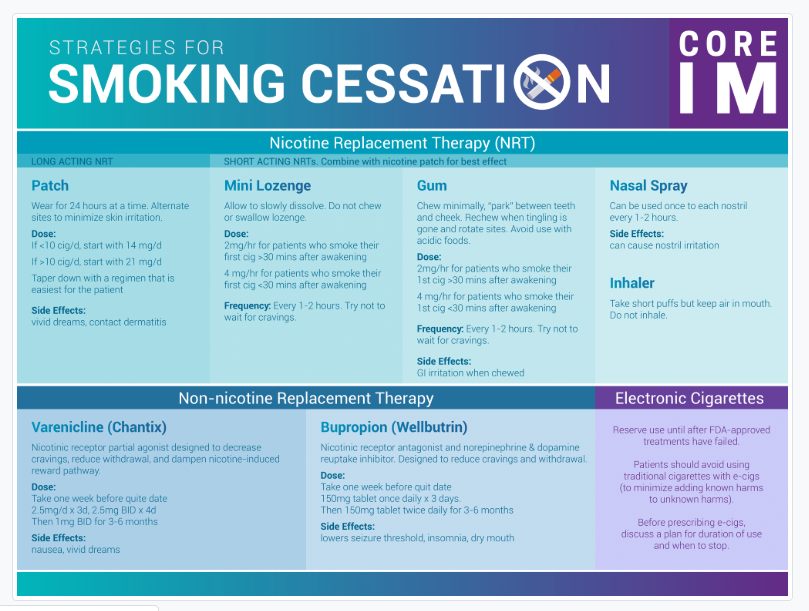In this post I excerpt from Core IM:
5 Pearls on Smoking Cessation
Posted: September 18, 2019
By: Dr. Susan Mirabal, Dr. Scott Sherman, Dr. Michael Fiore, Dr. Martin Fried and Dr. Shreya P. Trivedi
Graphic: Kabao Vang
Audio: Harit Shah
Peer Review: Dr Nancy Stewart, Dr. Allison Greco, Dr. Viren Kaul
Show Notes
Pearl 1
- Patients are more satisfied with their primary care providers who bring up smoking cessation and provide brief advice.
- It is important to acknowledge and celebrate prior attempts at smoking cessation as well as explore current and past barriers to quitting tobacco including concurrent alcohol use and potential for weight gain.
- Patients who favor quitting smoking abruptly have a higher likelihood of success than those who use a slow taper, perhaps highlighting some ambivalence that may be present when choosing tapering to a quit date.
- Establish a quit date and advise patients of support systems available such as 1-800-QUIT-NOW, www.smokefree.gov.
Pearl 2
- All forms of nicotine replacement therapy (NRT) can help people increase their probability of quitting by at least 50 to 60%, regardless of setting.
- Five nicotine replacement therapies are available to help patients quit: the nicotine patch, lozenge, gum, inhaler and nasal spray.
- Using combination NRTs increases chances of quitting tobacco by 25% than if using single therapy alone.
- [What this means is that it is a good idea to use both the patch and the mini-lozenge together.]
- Side effects of the nicotine patch, lozenge and gum include nausea and vivid dreams. The nicotine patch can also cause local skin irritation.
- The correct use of the nicotine gum is to “park” it between cheek and teeth until the peppery taste of nicotine wears off, then to re-chew and re-park. Nicotine needs an alkaline environment for absorption through the buccal mucosa. Avoid swallowing to limit GI side effects.
Pearl 3
- Varenicline is thought to promote smoking abstinence by decreasing tobacco cravings and nicotine withdrawal. It also diminishes the reinforcing reward pathway from smoking a cigarette, making cigarettes less enjoyable
- Varenicline about triples odds of quitting when compared to placebo.
- Side effects of varenicline include nausea and vivid dreams. Varenicline does NOT cause a significant increase in neuropsychiatric adverse events.
- Bupropion is another option for smoking cessation in patients with depressed mood, however it can lower the seizure threshold, and is not as effective as varenicline.
Pearl 4
[Vaping is a terrible idea. Don’t do it.]
Pearl 5
This is a review pearl from 5 Pearls on Barrett’s Esophagus
Posted: January 30, 2019
By: Dr. Vishal Shah, Dr. Milna Rufin, Dr. Martin Fried and Dr. Shreya P. Trivedi





